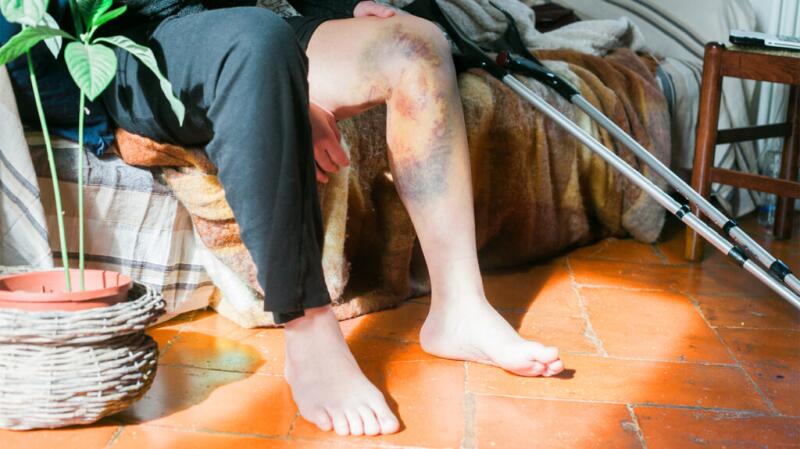This article discusses the symptoms of bruises and hematomas, some common causes of each, and when to contact a doctor or seek emergency medical care.
A hematoma is a pool of blood trapped outside a blood vessel. It is due to bleeding from a vascular structure, including vital organs.
Hematomas can occur in
A bruise, or a contusion, is a bleed into the skin that occurs when small blood vessels break. If there is no break in the skin, the blood stays inside, leading to discoloration. Bruising can involve muscles and bones as well.
Two
A large bruise is called ecchymosis, and these are larger than 1 centimeter.
Bruises and some hematomas can look similar, but there are many possible symptoms of a hematoma, depending on the location.
Hematoma signs and symptoms

A person can see a hematoma when it affects the skin. The symptoms of a hematoma are more severe than those of a bruise.
Symptoms may appear immediately after the injury, or they may take several days to show up.
Hematoma signs and symptoms include:
- pain
- tenderness
- skin discoloration
- swelling
If a lump appears, it is usually
Symptoms of a serious and life threatening hematoma, such as one that affects the brain, may include:
- headache
- vomiting
- dizziness
- confusion
- unequal pupil size
- slurred speech
- seizures
Get immediate medical attention for these symptoms.
Other hematomas may present
Bruise signs and symptoms
Bruises show up soon after the injury takes place.
Signs and symptoms of bruises include:
- skin discoloration, usually dark blue, purple, or black
- tenderness
- minor swelling
As the body breaks down the blood, the bruise color changes from bluish-purple to green to brownish-yellow before completely fading away. This usually takes about 2 weeks.
You will see the same colors for a hematoma near the skin, but these may take longer to fade away completely. A hematoma does not turn into a bruise.
While a bruise is not a hematoma, the two can result from similar things.
Causes of a hematoma
The location defines the type of hematoma, such as an abdominal hematoma, which one
Some hematomas are medical emergencies. These include intracranial, or subdural, hematomas, which develop due to blood collecting in the space between the skull and the brain.
Other hematoma causes include:
- trauma, such as from a fall
vaginal delivery Trusted Source PubMed Central Highly respected database from the National Institutes of Health Go to source - surgery
ruptured aneurysm Trusted Source PubMed Central Highly respected database from the National Institutes of Health Go to source - spontaneous bleeding
People who are
- are older
- take blood thinners
- have a bleeding disorder, such as
hemophilia Trusted Source Centers for Disease Control and Prevention (CDC) Governmental authority Go to source
Causes of a bruise
Bruises usually result from accidental injuries, such as bumps and falls.
As with hematomas, people who are more likely to bruise spontaneously, or for no apparent reason, include those who:
- are older
- have a bleeding disorder
- have a vitamin C deficiency
- take blood thinners
Older people, who have
If you develop symptoms of a hematoma after an injury or surgical procedure, contact a healthcare professional promptly.
Your doctor may request medical imaging tests, such as a CT scan or an MRI scan. You may also need treatment to drain the blood or repair the source of any active bleeding.
Some hematomas are life threatening. Hematomas that appear after any type of trauma can develop internally and damage organs, including the brain.
Seek medical attention or call 911 for symptoms of a subdural hematoma, including:
Evaluating bruises
Bruises are harmless in most cases. Depending on the type of injury you sustained, you may want to contact a doctor or nurse to evaluate a bruise.
A telehealth appointment may be sufficient for an initial evaluation. Your doctor will tell you if you need to follow up with an in-person appointment. An X-ray can determine if there is a fracture.
Contact a doctor if:
- The bruise does not go away within 2 weeks.
- You have a pattern of bruising, such as large or frequent bruises or petechiae.
- The bruise is very swollen, painful, or increasing in size.
- You cannot move the bruised area.
- The bruise is affecting your eye or vision.
Also, contact a medical professional for symptoms of infection, such as fever, increased swelling, or pain.
You can treat most bruises and some types of hematoma at home. Ice packs and over-the-counter pain relievers such as acetaminophen (Tylenol) can help ease any pain.
However, avoid ibuprofen (Advil, Motrin) and aspirin. These and other nonsteroidal anti-inflammatory drugs
For both bruises and hematomas, it is best to rest and avoid strenuous activity until the swelling subsides.
Bruise treatment
Bruises are often minor and do not typically require professional medical care.
You can treat a bruise by applying a cold compress for 15 minutes every hour. Do not put ice directly on your skin. Instead,
wrap ice or a bag of frozen peas in a towel. Also, elevate the bruised area as much as possible.
After 48 hours or when the swelling subsides, apply
Hematoma treatment
In people
For mild hematomas, treatment can begin at home with the same care options as for bruises.
Both bruises and hematomas result from bleeding and can be due to injuries, bleeding disorders, and other conditions.
A bruise involves small blood vessels of skin, muscle, or bone. A hematoma is a buildup of blood that can occur near the skin, such as at a surgical incision, but it can also occur within the skull or deep within the body.
A hematoma is worse than a bruise. In fact, some hematomas are life threatening.
First aid for a bruise or a mild, visible hematoma includes icing the area, elevating the body part, resting, and taking acetaminophen.
Contact a medical professional for a bruise or a hematoma after an impact or in the case of neurological symptoms, severe pain, or an increase in swelling.








